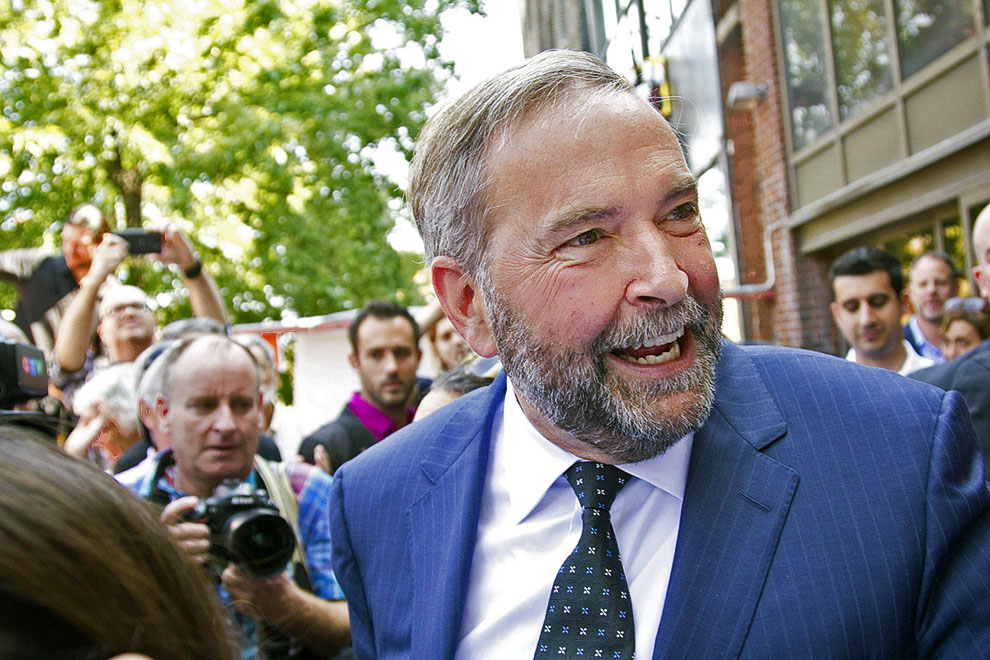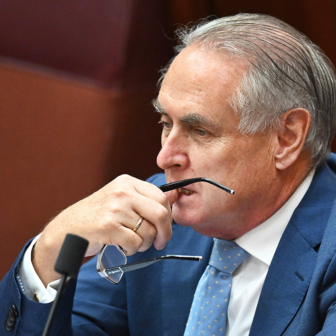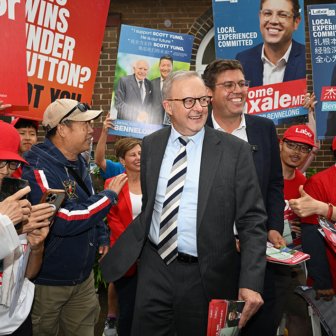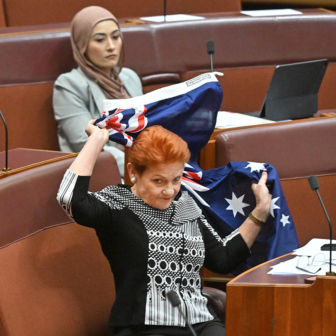Canadian parties are campaigning for office in what might be the country’s least predictable general election on record. Prime minister Stephen Harper’s Conservatives, in power since 2006, are hoping for their fourth straight victory. The leading opposition party, the left-wing New Democratic Party, has never held power at the federal level but is now tantalisingly close under leader Thomas Mulcair. And the centrist Liberal Party, which dominated Canadian politics in the twentieth century, hopes for a comeback under Justin Trudeau, son of one of its most successful leaders. Polls consistently suggest a tight three-way race, with no obvious frontrunner nor clear laggard in the run-up to election day on 19 October.
The dominating election issue is Harper himself, who heads perhaps the most polarising government in Canadian history. The divide is less about policies and more about the style and approach of the prime minister – a style that infuriates many but gratifies others, particularly those who feel the country has been governed too long by the urban elites of central Canada. For Harper’s many supporters, the election is about keeping their champion in power; for his opponents, it is about getting rid of him. But those opponents are left with the question of which major opposition party can best do the job. Under Canada’s single-member-plurality electoral system, they could easily cancel each other out and allow Harper a fourth straight victory.
This is not to say the election isn’t concerned with policy issues. After several years of reasonable performance, the Canadian economy is slipping into recession. Three energy pipelines – the Keystone oil pipeline into the United States, the Northern Gateway pipeline across northern British Columbia to the Pacific, and the Energy East line through Ontario and Quebec to the small province of New Brunswick – have attracted environmental controversy, as have the great energy projects in the northern Alberta oil sands (known to opponents as “tar sands”). The federal government has run a budget deficit since 2009 and is likely to keep doing so with the drop in energy revenues. The status and quality of life of Aboriginal Canadians remains critical, and while Quebec separatism is somewhat on the wane, the province retains its distinctive nationalism, and cultural and linguistic tensions continue to simmer.
Yet none of these issues spark debates as intense as those about Harper himself. He is the first and only leader of the Conservative Party of Canada, formed in 2003 to reconcile a decade-long split between the traditional right-wing party, the oxymoronically named Progressive Conservatives, and a renegade populist upstart, the Reform Party (later called the Canadian Alliance). From the Reform wing, Harper has dominated the party and shaped it in his own image, with strong central control and none of the organisational complexities and competing factions typically found in the older parties. The reconstituted party quickly rose from the ashes, winning a narrow minority of seats in 2006, a second minority in 2008, and a solid majority in 2011.
The Conservatives have steered a centre-right path. They are “tough on crime,” strong supporters of the energy pipelines and the oilsands development, deeply uninterested in environmental policy, and confrontational with unions. But they have also overseen steep increases in government spending, have been selective and cautious in granting tax cuts, and have generally tried to avoid engagement on divisive social conservative issues such as abortion or gay and lesbian rights. Ideologically, they are hard to pin down.
But their style is unmistakable. They have governed aggressively, gripping power tightly and operating within a cone of silence at every level. Government MPs and cabinet ministers are discouraged from speaking to the press; even senior ministers can’t give press interviews without clearance from the prime minister’s office. Public servants find themselves under similar tight control in every sphere; government scientists in particular have complained about restrictions on even the most innocuous communications. Harper himself gives few press conferences and they are tightly controlled.
With the government bending unwritten rules and conventions, the parliamentary agenda has been equally aggressive. This prompted a brief constitutional crisis in 2008 and a parliamentary vote of no confidence in 2011 after the speaker of the House ruled the entire government was in contempt of parliament for failing to release documents to a parliamentary committee. The government’s supporters are quick to point out the inherent flexibility of the Westminster system and similar rule-bending by previous leaders and other parties. At times the government seems to go out of its way to pick fights, such as with its decision in 2010 to modify the national census, for reasons never fully explained, prompting the resignation of the national statistician and widespread complaints from experts of all kinds.
Harper is uniformly unapologetic. He makes clear he is in charge and that Canadians have the final verdict – re-electing him twice so far, including in 2011 following the contempt-of-parliament charge. He is hardly the first prime minister to be accused of parliamentary rule-bending and politicising government. And he can and will argue that petty insider detail is not of interest to anyone but urban and intellectual elites.
The bastion of Conservative support is in western and rural Canada and the outer suburbs, and though Harper has a graduate degree in economics, anti-intellectualism comes naturally to him. His swipes at the “media elites” are legion, and after a terrorist attack in 2013 he said, somewhat confusingly, “this is not the time to commit sociology.” In turn, the loathing of these elites is unmistakable. Numerous books, documentaries and artistic works are dedicated to unmasking the evils of Harper, but every squeal probably only makes him happier. There is no Canadian equivalent to the Australian term “battlers,” but Stephen Harper clearly feels that he speaks for the ordinary suburban masses (“moms and dads” is his preferred phrase) who are too busy living their lives to follow politics closely. A personally modest individual with a bland family man image, Harper’s preferred recreation while in office has been to write a book on the history of ice hockey. He resonates deeply with millions of Canadians.
This, then, is the government running for re-election. And while its opponents can articulate its many sins, electoral imperatives mean they must also spend much of their time fighting each other.
Let’s begin with the third-placed party, the Liberals. Having run the country for much of the twentieth century, the Liberals consider themselves the natural governing party, balanced in the pragmatic centre (“campaign from the left, govern from the right” was one famous Liberal mantra) and generally trying to please all of the people all of the time. But the party has fallen on hard days, wounded by a major corruption scandal and disastrous civil war that led it to lose power in 2006. The party then turned to two successive leaders with PhDs and impeccable intellectual credentials, only to sink deeper and suffer its worst performance in history in 2011, with the New Democrats passing it into second place.
The party has now put itself in the hands of Justin Trudeau, eldest child of the late Pierre Trudeau, the erudite intellectual who was prime minister in the 1970s and 1980s. The forty-three-year-old younger Trudeau possesses his father’s charm and sex appeal in spades, but not necessarily his other credentials, and had no particular profession or notable accomplishments prior to running for office in his late thirties. While he is a far more effective campaigner than his immediate predecessors, the chief Conservative slogan being used against Justin is “Just Not Ready.”
In contrast, this is the moment for the New Democratic Party, or NDP, a leftist social democratic party that has formed several provincial governments but never come close to national power. Its former leader, Jack Layton, led the party to unprecedented heights in 2011, especially in Quebec, where it had long been a non-entity. Layton died a few months later and was succeeded by Thomas Mulcair, a Montrealer and, until 2011, the party’s sole Quebec MP.
Mulcair is virtually the opposite of Justin Trudeau – an articulate, sharp debater with deep gravitas and experience in provincial government. Despite the occasional nickname “Angry Tom,” he has cultivated a strong appeal both in Quebec and across Canada, including in areas long written off by the NDP. Both he and the party have great momentum. Yet Mulcair also struggles to articulate his vision for the country. He is a relative newcomer to a party that lacks a presence in Quebec provincial politics, where he built his reputation, and many of the more traditional leftist elements of the party view him with suspicion. His parliamentary caucus remains inexperienced (many of its Quebec MPs were shocked to find themselves elected in 2011, including several students who had to drop out of school to take their seats in parliament) and he runs his party with almost as firm a hand as Harper runs his.
The Liberals and New Democrats both argue they are the best choice to stop Stephen Harper, though they have only gradually articulated their own visions. Often their positions are similar; for example, both parties oppose the Keystone and Northern Gateway pipelines, but have evaded taking a position on Energy East, whose popularity varies enormously by region. As the election progresses, though, the centrist and leftist parties almost seem to have switched places. Mulcair and the NDP have tried to steer a middle course to avoid being labelled free-spending socialists, pledging balanced budgets and no tax increases except on large corporations. The traditionally centrist Liberals have committed to aggressive new spending, even at the cost of running ongoing budget deficits. Overall, though, the differences between the parties are subtle rather than stark, offering blurry choices to voters beyond their common anti-Harper stance.
The other key player is the Canadian electoral system. Its single-member-plurality system, similar to Britain’s, allows voters to express only a single preference. With the electorate so polarised between pro- and anti-Harper sentiments, this system tends to favour the Conservatives, who won the last election with under 40 per cent of the vote, while their opponents split the remainder. (Space precludes me from discussing two further opposition parties that will pick up some anti-Conservative sentiment, the marginal Greens and the regional Bloc Québécois.) Of course, the same system worked against the squabbling right-wing parties in the 1990s, allowing a string of Liberal victories.
In a country where turnout has been declining for two decades, the absence of compulsory voting laws also puts a premium on getting supporters to show up. The Conservatives are widely considered to have the most fervent base, and have shown great skill in tracking their supporters and getting them to the ballot box. The Liberal and NDP bases are more fickle, and even fervent anti-Harper messages may be insufficient to motivate crucial but disengaged voters. Money also plays a role. While Canadian election finance is somewhat more tightly regulated than in Australia, and has reached nowhere near the obscene levels found in the United States, fundraising remains essential. The Conservatives – again with the most fervent supporters – have been most effective at building a war chest.
With the polls often showing near three-way ties between the parties, who is likely to win? It may well be the Conservatives once again. Their supporters are dedicated, the electoral rules are favourable, and they are formidable campaigners. Given the very real possibility of a Conservative re-election, some argue that the Liberals and NDP must band together, running shared candidates and/or being prepared to form a coalition government. (They briefly attempted this in 2008, but it is virtually unprecedented in modern Canadian politics.) The parties have very different traditions with distinct cultures and ideological bases, though, and they show little inclination to cooperate. Ultimately, for all their aggressiveness and controlling ways, the Conservatives have been remarkably deft in steering the country and retaining the political support they need to continue. No one should count out the possibility that Stephen Harper will win once again. •




